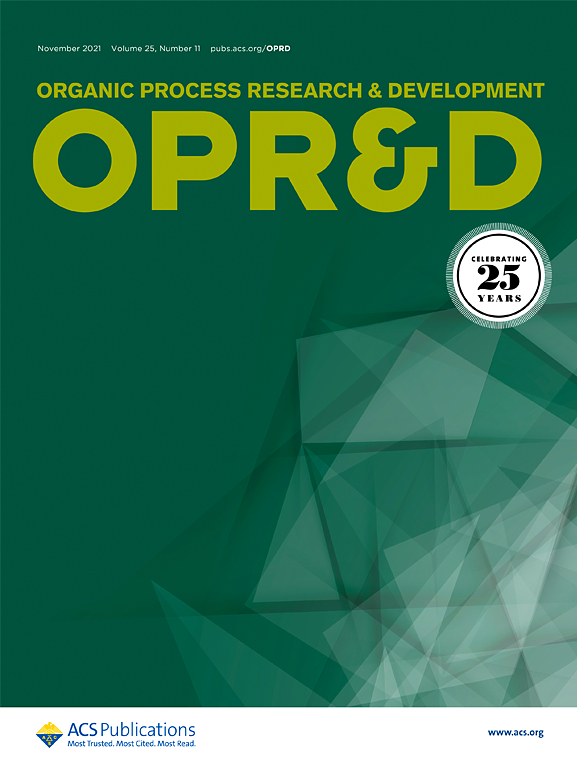微反应器中二苯基亚砜的连续流动合成及动力学研究
IF 3.1
3区 化学
Q2 CHEMISTRY, APPLIED
引用次数: 0
摘要
过氧化氢(H2O2)氧化二苯基硫化物(DPS)合成二苯基亚砜(DPSO)是一种极放热的反应,具有很高的热危险性。当发生热失控时,可能会导致设备损坏甚至爆炸。为此,本文采用微反应器降低反应热风险,并对工艺条件进行了优化。以磷钨酸(PTA)为催化剂,系统考察了反应温度、停留时间、催化剂浓度、摩尔比等工艺条件对转化率和收率的影响。结果表明,在催化剂负载0.75%、停留时间25 min、反应温度70℃、H2O2-DPS摩尔比为2的条件下,DPSO收率可达84.3%。然后,研究了表观反应动力学,建立并验证了动力学模型。通过改变H2O2和DPS的初始浓度,确定反应为二级反应,活化能为57.5 kJ·mol-1,指前因子为2.96 × 107 mol-1·L·min-1。通过热平衡与反应动力学的结合,估计了微反应器的温度分布。结果表明,在1/16 in。微反应器,反应几乎是等温的。对不同直径和不同材料的微反应器的温度分布进行了预测。结果表明,该反应可以安全地放大到3/8 in。在反应温度为55℃的微反应器中,最大温升保持在5℃以下,DPSO产率没有下降。该研究为指导流动反应器中反应的安全定量提供了一种方便的方法。本文章由计算机程序翻译,如有差异,请以英文原文为准。

Continuous Flow Synthesis and Kinetic Study of Diphenyl Sulfoxide in a Microreactor
The oxidation of diphenyl sulfide (DPS) by hydrogen peroxide (H2O2) to synthesize diphenyl sulfoxide (DPSO) is extremely exothermic and has a high thermal risk. When thermal runaway happens, it may lead to equipment damage or even explosions. Therefore, in this work, a microreactor was adopted to reduce reaction thermal risk and process conditions were optimized. Phosphotungstic acid (PTA) was used as the catalyst, and the effects of process conditions, including reaction temperature, residence time, catalyst concentration, and molar ratio on the conversion and yield were systematically investigated. The results showed that the DPSO yield could reach up to 84.3% under the condition of 0.75% catalyst loading, 25 min residence time, 70 °C reaction temperature, and H2O2–DPS molar ratio of 2. Then, apparent reaction kinetics were studied, and a kinetic model was established and validated. By varying the initial concentrations of H2O2 and DPS, the reaction was determined to be of second-order, with an activation energy of 57.5 kJ·mol–1 and a pre-exponential factor of 2.96 × 107 mol–1·L·min–1. Furthermore, the temperature distribution along the microreactor was estimated by combining the thermal equilibrium with the reaction kinetics. The results indicated that in a 1/16 in. microreactor, the reaction was nearly isothermal. Temperature distributions were also predicted for microreactors with different diameters and materials. It was demonstrated that the reaction could be safely scaled up to a 3/8 in. microreactor at a reaction temperature of 55 °C, with the maximum temperature rise remaining below 5 °C and no decline in DPSO yield. This study provided a convenient method to guide the safe sizing-up of the reaction in flow reactors.
求助全文
通过发布文献求助,成功后即可免费获取论文全文。
去求助
来源期刊
CiteScore
6.90
自引率
14.70%
发文量
251
审稿时长
2 months
期刊介绍:
The journal Organic Process Research & Development serves as a communication tool between industrial chemists and chemists working in universities and research institutes. As such, it reports original work from the broad field of industrial process chemistry but also presents academic results that are relevant, or potentially relevant, to industrial applications. Process chemistry is the science that enables the safe, environmentally benign and ultimately economical manufacturing of organic compounds that are required in larger amounts to help address the needs of society. Consequently, the Journal encompasses every aspect of organic chemistry, including all aspects of catalysis, synthetic methodology development and synthetic strategy exploration, but also includes aspects from analytical and solid-state chemistry and chemical engineering, such as work-up tools,process safety, or flow-chemistry. The goal of development and optimization of chemical reactions and processes is their transfer to a larger scale; original work describing such studies and the actual implementation on scale is highly relevant to the journal. However, studies on new developments from either industry, research institutes or academia that have not yet been demonstrated on scale, but where an industrial utility can be expected and where the study has addressed important prerequisites for a scale-up and has given confidence into the reliability and practicality of the chemistry, also serve the mission of OPR&D as a communication tool between the different contributors to the field.

 求助内容:
求助内容: 应助结果提醒方式:
应助结果提醒方式:


